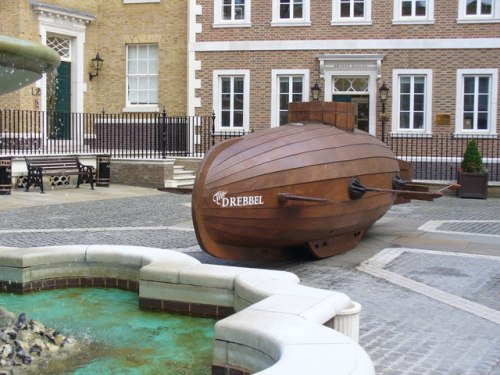
The Drebbel Reconstruction of a wooden submarine which was oar-powered! This reconstruction proved itself in the Thames. It now sits in an enclosed yard by Richmond bridge.
Attribution: Colin Smith
The history of submarine design and construction is a lot like taking a loaded brush, flinging towards a wall, and declaring the wall painted. Huge parts of the history are missing and what we do have is scattered and disconnected. The earliest design we have comes from Leonardo da Vinci. He kept his design secret. When it was finally discovered and examined by modern engineers they discover that it would not have been able to submerge.
The first design to actually be built and tested appears to be one from Cornelius Drebbel in 1620. He studied an earlier design by William Bourne from 1578. Drebbel’s third submarine was demonstrated in 1624 for the King of England and the Admiralty. He used a wooden frame covered in leather and powered by 6 oars. In 1729, Nathaniel Symons designed a submarine which surfaced and sank by expanding and contracting the volume of the submarine.
In 1775, David Bushnell designed and built the Turtle, which was brought to the attention of General Gorge Washington by the governor of Connecticut. Bushnell was from Westbrook, Connecticut and designed the sub while he was studying at Yale. He proved that gunpowder could be exploded underwater and made the first time bomb. General Washington had his doubts about the machine, but supplied the funds and support for the submarine to be built.
The Turtle was ten feet long, six feet tall, and three feet wide. It submerged by taking water into a ballast tank at the bottom of the sub and surfaced by pumping the water out with a hand pump. Propulsion was a hand crank screw propeller, and up and down motion was accomplished with another hand crank screw propeller. The weapon was a powder keg attached to the submarine. It would go under the target ship and bore into it with a wood screw attaching the powder keg to the hull of the target. It would move away from the target and a clock mechanism would start. When the mechanism counted out, it activated a flintlock firing mechanism which exploded the powder keg blasting a hole in the target and sinking it. Or that was the plan anyway.
Ezra Bushnell, David’s brother and pilot of the Turtle, was sick when the attack against the British was to take place. General Samuel Parsons provided three volunteers to train on the Turtle. When the attack against Admiral Howe’s flagship, the HMS Eagle, took place Sergeant Ezra Lee was the pilot. Sgt. Lee was unable to attach the bomb, because the screw for attaching the bomb struck metal. (Probably the iron fittings which mount the rudder of the ship, though some say it was the copper sheathing of the hull, this is doubtful).
As Sgt. Lee was returning British soldiers on Governor’s Island spotted the sub and rowed out to investigate. Lee released the charge, thinking the British would be curious and pick it up, exploding and killing them all. The soldiers were suspicious and returned to the island staying clear of the bomb. The bomb drifted into the East River where it exploded harmlessly.
Another attack was made against another ship anchored off of Manhattan Island. A lookout on the ship spotted the Turtle and Lee aborted the attack. Several days later the Turtle was being transported aboard a ship when the ship was sunk by the British. Bushnell said he salvaged the Turtle, but no record of what happened to the ship exists.
David Bushnell stayed in the Continental Army until the end of the Revolutionary War. He then moved to Georgia where he died in 1824.


